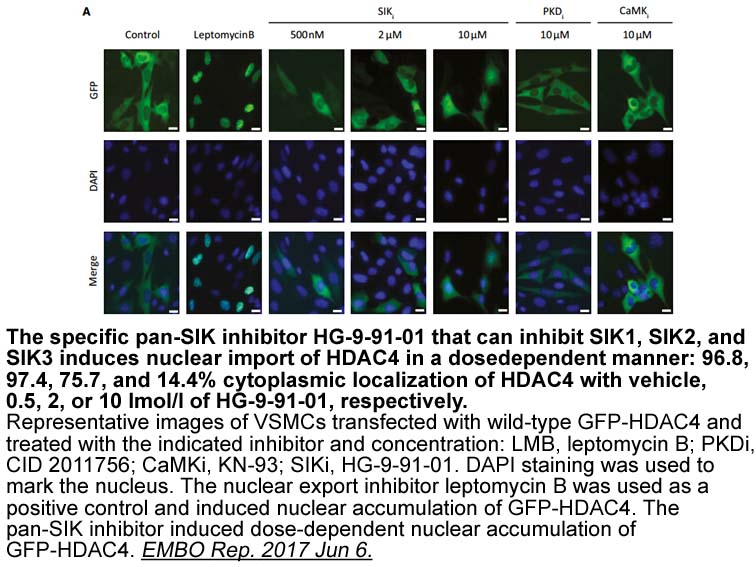Archives
ASK belongs to the family of MAPKKK ASK mediated apoptosis
ASK1 belongs to the family of MAPKKK. ASK1-mediated apoptosis is involved in the pathogenesis of several diseases such as I/R injury, infectious diseases and neurodegenerative disorders [33], [34], [35]. ASK1 can be activated through different mechanisms. One mechanism is that oxidative stress directly induces Vatalanib receptor of ASK1, a process correlated with enhanced ASK1 activity and increased apoptosis [36]. A series of studies using ASK1-deficient mice have highlighted the importance of stress-dependent ASK1 activation in vivo[37], [38]. For example, ASK1-deficient mice show decreased infarct size and increased resistance to myocardial cell death when subjected to myocardial I/R injury in which ROS play a critical role [38]. In our present study, treatment of cardiac myocytes with DOX results in activation of ASK1 as indicated by an increase in ASK1 phosphorylation. Inhibition of ASK1 with siRNA attenuated DOX-induced ASK1 phosphorylation and myocyte apoptosis. The analysis of ASK1-deficient mice has also demonstrated the requirement of the ASK1/JNK pathway for cardiomyocyte apoptosis [38]. JNK is activated by its upstream kinase ASK1. In the present study, our results indicate that DOX-induced phosphorylation of JNK is regulated by ASK1 activation based on following evidences, (1) DOX induced activation of ASK1 at 15 min, and increased phosphorylation of JNK at 30-120min, which implied that JNK might be the downstream event to the activation of ASK1 in DOX-induced apoptosis; (2) Suppression of ASK1 was associated with a reduced level of JNK activation. However, suppression of JNK had no effect on activation of ASK1.
There are some limitations in our study. As mentioned above, IL-33 is initially described as a kind of inflammatory cytokine [7], [8], [9]. We should study the inflammatory effects of IL-33, especially the histological changes in heart, in the following study. In addition, if we want to make our study more convincible, we should make sure that IL-33 does not affect oncologic effectiveness of DOX. Otherwise, the clinical use of IL-33 for DOX-induced cardiac injury will be postponed.
injury in which ROS play a critical role [38]. In our present study, treatment of cardiac myocytes with DOX results in activation of ASK1 as indicated by an increase in ASK1 phosphorylation. Inhibition of ASK1 with siRNA attenuated DOX-induced ASK1 phosphorylation and myocyte apoptosis. The analysis of ASK1-deficient mice has also demonstrated the requirement of the ASK1/JNK pathway for cardiomyocyte apoptosis [38]. JNK is activated by its upstream kinase ASK1. In the present study, our results indicate that DOX-induced phosphorylation of JNK is regulated by ASK1 activation based on following evidences, (1) DOX induced activation of ASK1 at 15 min, and increased phosphorylation of JNK at 30-120min, which implied that JNK might be the downstream event to the activation of ASK1 in DOX-induced apoptosis; (2) Suppression of ASK1 was associated with a reduced level of JNK activation. However, suppression of JNK had no effect on activation of ASK1.
There are some limitations in our study. As mentioned above, IL-33 is initially described as a kind of inflammatory cytokine [7], [8], [9]. We should study the inflammatory effects of IL-33, especially the histological changes in heart, in the following study. In addition, if we want to make our study more convincible, we should make sure that IL-33 does not affect oncologic effectiveness of DOX. Otherwise, the clinical use of IL-33 for DOX-induced cardiac injury will be postponed.
Conflicts of interest
Acknowledgments
The work is supported by Social Development Foundation of Zhenjiang City (SH2015037) and the project of Key young medical talent of Jiangsu Province (QNRC2016452).
Introduction
Neuroblastoma (NB) is a childhood solid tumor that is thought to derive from sympathetic neural crest cells [1]. Despite recent advances in multi-modal therapy, patients with high-risk NB exhibit resistance to conventional treatments. Consistent with their neural crest origins, NB cells may self-renew, differentiate into neural and neuroendocrine cells, and express genes observed in neural stem cells. We and others previously reported that one of these genes, the orphan nuclear receptor Drosophila tailless homologue (TLX), plays a significant role in the functional regulation of the vertebrate brain through its effects on the neural stem cell compartment [2], [3], [4], [5], [6]. TLX also controls cellular differentiation and self-renewal in neural stem cells by regulating the expression of a network of target genes [6], [7], [8], [9], [10], [11], [12]. Elevated TLX expression correlates with unfavorable prognosis in NB and is required for self-renewal of NB cells [12]. In NB, TLX controls angiogenesis through interaction with the von Hippel-Lindau protein (pVHL) [13]. In the presence of oxygen, the hypoxia-inducing factor (HIF)-α is prolyl-hydroxylated, and following interactions with the E3 ubiquitin ligase pVHL, HIF-α is degraded by a proteasome [14]. We reported that the interaction of TLX and VHL in normoxia leads to stabilization of HIF-2α, whereas in hypoxia TLX binds to the endothelial growth factor (VEGF) promoter [13], [15]. Our results suggest a role for TLX in regulating angiogenesis, in addition to its role in self-renewal in NB cells.